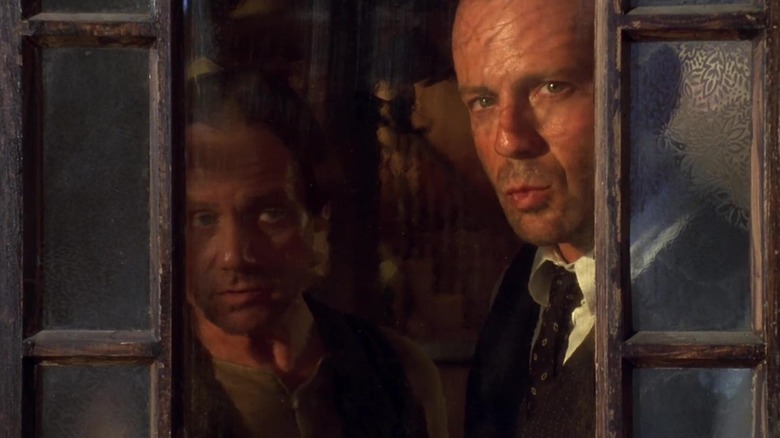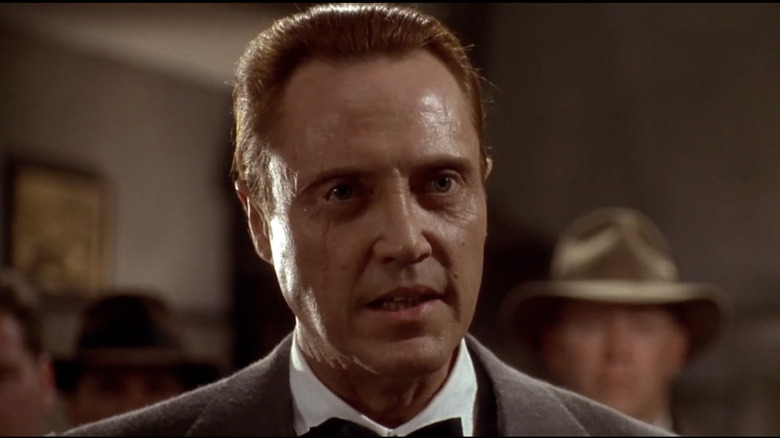Commissions may be earned from purchases through the links provided.
New Line Cinema
In the comprehensive film biography “The Emperor and the Wolf,” written by Stuart Galbraith IV, a detailed account of the collaborations between the renowned director Akira Kurosawa and actor Toshiro Mifune is explored. During a conversation about Sergio Leone’s Western “A Fistful of Dollars,” Kurosawa reportedly proclaimed it was a “good film, but it’s my film.” Leone, as most film enthusiasts will be aware, took significant inspiration from Kurosawa’s 1961 film “Yojimbo” when creating “A Fistful of Dollars.” Leone’s film so closely mirrored “Yojimbo” that Toho, the company that distributed Kurosawa’s film, filed a lawsuit, which was eventually settled out of court.
For the uninformed, “Yojimbo” tells the story of a nameless ronin (Mifune) who stumbles upon a remote 1860s village embroiled in a brutal gang war. This conflict arises from two rival yakuza factions battling for gambling rights in the town, which is seemingly devoid of any other residents besides the gangsters. The anonymous ronin, with a mix of bitterness and bemusement, starts manipulating both sides, hoping they obliterate each other. “Yojimbo” is a remarkably cynical piece from Kurosawa’s repertoire.
A History of “Yojimbo” Remakes and Reimaginings
“Yojimbo” has served as the basis for numerous remakes and reinterpretations throughout cinematic history. In 1970, the film “Django,” starring Franco Nero, echoed the “Yojimbo” concept in a Wild West scenario. That same year, Hiroshi Inagaki directed “Incident at Blood Pass,” featuring Mifune in a role reminiscent of his character in “Yojimbo.” Fast forward to 1984, and John C. Broderick’s “The Warrior and the Sorceress” brought the “Yojimbo” narrative into a Dark Ages fantasy setting.
Then, in 1996, Walter Hill attempted to recreate “Yojimbo” with “Last Man Standing.” This film, a fusion of Western and gangster genres, saw Bruce Willis step into Mifune’s shoes, with the plot shifted to Texas during Prohibition. Unfortunately, it was a complete failure.
Walter Hill’s Failed Attempt at Recreating Kurosawa’s Masterpiece

New Line Cinema
“Last Man Standing,” while similar in premise and plot to “Yojimbo” (Kurosawa was given credit this time), showcased Willis in a markedly different “lone wolf” role. In “Yojimbo,” Mifune’s nameless ronin is a cynic, aloof and amused, happy to force warring gangs into battle, not caring for their lives. Indeed, in one notable scene, Mifune runs from one gang to the next as they are about to clash in the middle of the town’s thoroughfare. He essentially gives them direction before retreating to a tower to witness the ensuing mayhem, just like a film director might.
Contrastingly, Willis is more silent and steely, taking his cues from Clint Eastwood’s “Fistful” take on the character at least as much as from Mifune’s. He comes across as distant and taciturn, less indifferent as unaware. Willis, a fine actor in his own right, was let down by poor direction in this film. Moreover, “Last Man Standing” amplified “Yojimbo” with more action, but in the extra-brutal, post “Pulp Fiction” mold, where characters never stop to assess the damage. Everything feels low-energy and dour. Hill, normally an energetic director, created something so stone-faced as to be detached and boring.
The gang bosses are transposed directly from “Yojimbo,” with Ned Eisenberg and David Patrick Kelley playing Italian and Irish versions of the yakuza lords, respectively. Hill, however, also adds a femme fatale character played by Alexandra Powers, with Christopher Walken portraying an ultra-dangerous Italian gunman.
Critics’ Lackluster Reception of Last Man Standing

New Line Cinema
“Last Man Standing” features a stylized and surreal setting but doesn’t manage to be fun. Transposing “Yojimbo” to a 1920s gang war, complete with fedoras and tommy guns, would make sense, but Hill insisted on maintaining the Western backdrop, forcing his Prohibition-era mobsters into the same dusty Old West village that Clint Eastwood wandered into. This visual juxtaposition of stylishly dressed men wandering through a dusty one-horse town was a visual misstep; it’s not dynamic, it’s mismatched.
Despite being derived from a classic, Hill’s remake failed to captivate audiences. “Last Man Standing” had a hefty production cost of $67 million but only managed to gross $18 million at the domestic box office, making it a substantial flop. Critics were also unimpressed, many citing the aforementioned detached tone. Roger Ebert wrote that it was “a cheerless film, so dry and laconic and wrung out, that you wonder if the filmmakers ever thought that in any way it could be… fun.” That’s pretty spot-on. Mitchell Beaupre, writing for Paste, was a little more positive, complimenting Hill’s skill at staging action set pieces.
In the years following the film’s release, it’s rarely been mentioned aside from in Walter Hill retrospectives. “Last Man Standing” is simply not a good film, having comfortably slipped into obscurity. It’s drab and forgettable.
We can undoubtedly expect more re-imaginings of “Yojimbo” in the future. However, this one can be safely skipped.
FAQs about Last Man Standing
Q: Who directed “Last Man Standing”?
A: “Last Man Standing” was directed by Walter Hill.
Q: What year was “Last Man Standing” released?
A: “Last Man Standing” was released in 1996.
Q: Was “Last Man Standing” a successful film?
A: No, “Last Man Standing” was not a successful film. It was a box office flop and received poor reviews from critics.
Q: What was “Last Man Standing” based on?
A: “Last Man Standing” was based on Akira Kurosawa’s 1961 film “Yojimbo.”
Q: Who starred in “Last
Credit: www.slashfilm.com


